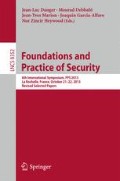Abstract
In this paper, we propose a novel framework for group authentication and key exchange protocols. There are three main advantages of our framework. First, it is a general one, where different cryptographic primitives can be used for different applications. Second, it works in a one-to-multiple mode, where a party can authenticate several parties mutually. Last, it can provide several security features, such as protection against passive adversaries and impersonate attacks, implicit key authentication, forward and backward security. There are two types of protocols in our framework. The main difference between them is that the authenticator in Type II has a certificate while in Type I does not. Under the general framework, we also give the details of protocols based on Diffie-Hellman key exchange system, and discrete logarithm problem (DLP) or elliptic curve discrete logarithm problem (ECDLP) based ElGamal encryption respectively. Session keys will be established at the end of each session and they can be utilized later to protect messages transmitted on the communication channel.
Access this chapter
Tax calculation will be finalised at checkout
Purchases are for personal use only
References
Huiping, J.: Strong password authentication protocols. In: 4th International Conference on Distance Learning and Education (ICDLE), pp. 50–52 (2010)
Ghanbarimaman, R., Pour, A.: A new definition of group authentication increasing performance of server calculation. In: International Conference on Information Science and Applications (ICISA), pp. 1–6 (2012)
Ren, K., Lou, W., Zhang, Y.: Multi-user broadcast authentication in wireless sensor networks. In: 4th Annual IEEE Communications Society Conference on Sensor, Mesh and Ad Hoc Communications and Networks (SECON ’07), pp. 223–232 (2007)
Harn, L.: Group authentication. IEEE Trans. Comput. 62(9), 1893–1898 (2013)
Blake, I., Gao, X., Mullin, R., Vanstone, S., Yaghoobian, T.: The discrete logarithm problem. In: Menezes, A. (ed.) Applications of Finite Fields. The Springer International Series in Engineering and Computer Science, vol. 199, pp. 115–138. Springer, New York (1993)
Hankerson, D., Menezes, A.: Elliptic curve discrete logarithm problem. In: Tilborg, H. (ed.) Encyclopedia of Cryptography and Security, pp. 186–189. Springer, New York (2005)
Elgamal, T.: A public key cryptosystem and a signature scheme based on discrete logarithms. IEEE Trans. Inf. Theor 31(4), 469–472 (1985)
Zhao, J., Gu, D.: A security patch for a three-party key exchange protocol. Wuhan Univ. J. Nat. Sci. 15(3), 242–246 (2010)
Zhang, X.L.: Authenticated key exchange protocol in one-round. In: Hua, A., Chang, S.L. (eds.) Algorithms and Architectures for Parallel Processing. LNCS, vol. 5574, pp. 226–233. Springer, Heidelberg (2009)
Chaum, D., Van Heyst, E.: Group signatures. In: Proceedings of the 10th Annual International Conference on Theory and Application of Cryptographic Techniques (EUROCRYPT’91), pp. 257–265. Springer, Heidelberg (1991)
Rivest, R., Shamir, A., Tauman, Y.: How to leak a secret: theory and applications of ring signatures. In: Goldreich, O., Rosenberg, A., Selman, A. (eds.) Theoretical Computer Science. LNCS, vol. 3895, pp. 164–186. Springer, Heidelberg (2006)
Guo, H., Wu, Y., Chen, H., Ma, M.: A batch authentication protocol for v2g communications. In: 4th IFIP International Conference on New Technologies, Mobility and Security (NTMS), pp. 1–5 (2011)
Johnson, D., Menezes, A., Vanstone, S.: The elliptic curve digital signature algorithm (ecdsa). Int. J. Inf. Sec. 1(1), 36–63 (2001)
Farah, A., Khali, H.: Joint multiple signature scheme for group-oriented authentication and non-repudiation. In: IEEE GCC Conference, pp. 1–5 (2006)
Bellare, M., Neven, G.: Multi-signatures in the plain public-key model and a general forking lemma. In: Proceedings of the 13th ACM conference on Computer and communications security (CCS ’06), pp. 390–399. ACM, New York (2006)
Yeh, L.Y., Huang, Y.L., Joseph, A., Shieh, S., Tsaur, W.: A batch-authenticated and key agreement framework for p2p-based online social networks. IEEE Trans. Veh. Technol. 61(4), 1907–1924 (2012)
Merkle, Ralph C.: One way hash functions and DES. In: Brassard, G. (ed.) CRYPTO 1989. LNCS, vol. 435, pp. 428–446. Springer, Heidelberg (1990)
Tsiounis, Y., Yung, M.: On the security of elgamal based encryption. In: Imai, H., Zheng, Y. (eds.) Public Key Cryptography. LNCS, vol. 1431, pp. 117–134. Springer, Heidelberg (1998)
Boneh, D.: The decision Diffie-Hellman problem. In: Buhler, J. (ed.) Algorithmic Number Theory. LNCS, vol. 1423, pp. 48–63. Springer, Heidelberg (1998)
Chiou, G.H., Chen, W.T.: Secure broadcasting using the secure lock. IEEE Trans. Softw. Eng. 15(8), 929–934 (1989)
Bellare, M., Rogaway, P.: Random oracles are practical: a paradigm for designing efficient protocols. In: Proceedings of the 1st ACM conference on Computer and communications security. CCS ’93, pp. 62–73. ACM, New York (1993)
Boneh, Dan: The decision Diffie-Hellman problem. In: Buhler, Jeremy P. (ed.) ANTS 1998. LNCS, vol. 1423, pp. 48–63. Springer, Heidelberg (1998)
Fridrich, J., Goljan, M.: Robust hash functions for digital watermarking. In: Proceedings on the International Conference on Information Technology: Coding and Computing, pp. 178–183 (2000)
Author information
Authors and Affiliations
Corresponding author
Editor information
Editors and Affiliations
Rights and permissions
Copyright information
© 2014 Springer International Publishing Switzerland
About this paper
Cite this paper
Yang, H., Jiao, L., Oleshchuk, V.A. (2014). A General Framework for Group Authentication and Key Exchange Protocols. In: Danger, J., Debbabi, M., Marion, JY., Garcia-Alfaro, J., Zincir Heywood, N. (eds) Foundations and Practice of Security. FPS 2013. Lecture Notes in Computer Science(), vol 8352. Springer, Cham. https://doi.org/10.1007/978-3-319-05302-8_3
Download citation
DOI: https://doi.org/10.1007/978-3-319-05302-8_3
Published:
Publisher Name: Springer, Cham
Print ISBN: 978-3-319-05301-1
Online ISBN: 978-3-319-05302-8
eBook Packages: Computer ScienceComputer Science (R0)

